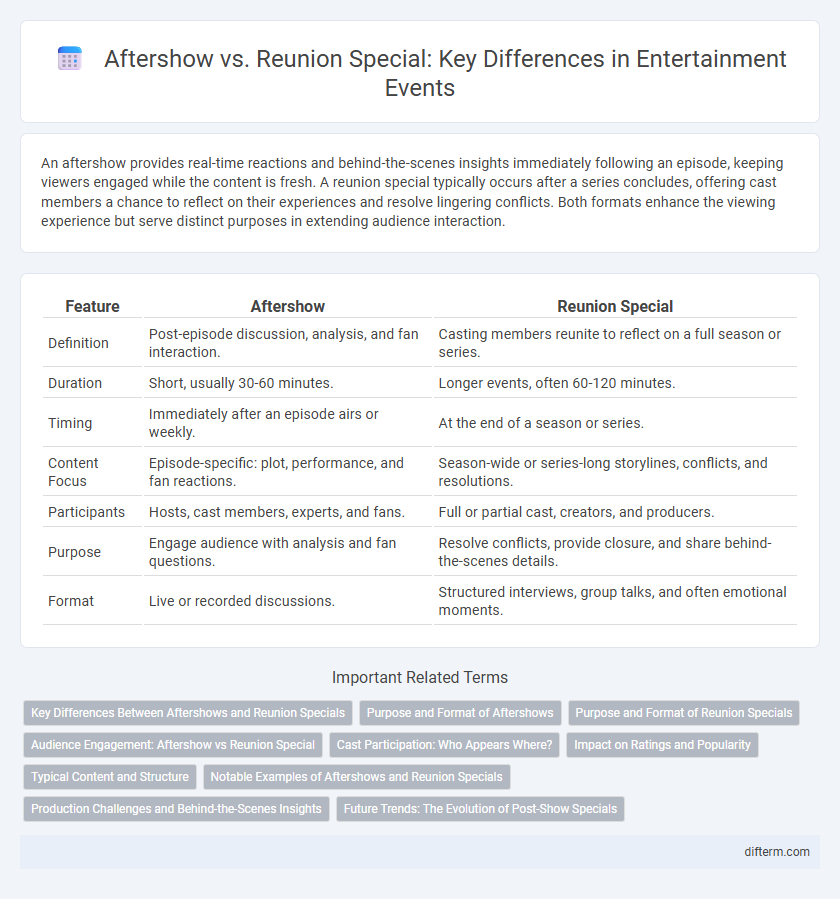An aftershow provides real-time reactions and behind-the-scenes insights immediately following an episode, keeping viewers engaged while the content is fresh. A reunion special typically occurs after a series concludes, offering cast members a chance to reflect on their experiences and resolve lingering conflicts. Both formats enhance the viewing experience but serve distinct purposes in extending audience interaction.
Table of Comparison
| Feature | Aftershow | Reunion Special |
|---|---|---|
| Definition | Post-episode discussion, analysis, and fan interaction. | Casting members reunite to reflect on a full season or series. |
| Duration | Short, usually 30-60 minutes. | Longer events, often 60-120 minutes. |
| Timing | Immediately after an episode airs or weekly. | At the end of a season or series. |
| Content Focus | Episode-specific: plot, performance, and fan reactions. | Season-wide or series-long storylines, conflicts, and resolutions. |
| Participants | Hosts, cast members, experts, and fans. | Full or partial cast, creators, and producers. |
| Purpose | Engage audience with analysis and fan questions. | Resolve conflicts, provide closure, and share behind-the-scenes details. |
| Format | Live or recorded discussions. | Structured interviews, group talks, and often emotional moments. |
Key Differences Between Aftershows and Reunion Specials
Aftershows provide real-time reactions and commentary immediately following an episode, allowing fans to engage through discussions, interviews, and behind-the-scenes insights. Reunion specials, however, occur after a series or season concludes, focusing on cast reflections, unresolved conflicts, and personal growth since filming ended. These distinctions highlight aftershows' emphasis on episode-specific engagement versus reunions' broader retrospection and closure.
Purpose and Format of Aftershows
Aftershows serve as supplementary content designed to enhance audience engagement by providing episode recaps, cast interviews, and behind-the-scenes insights shortly after the original broadcast. Typically formatted as informal panel discussions or interviews, they allow fans to delve deeper into plot developments and character motivations. This format fosters real-time interaction and community building, often featuring live social media integration and viewer questions.
Purpose and Format of Reunion Specials
Reunion specials serve to reunite cast members and key creatives to reflect on the show's development, behind-the-scenes moments, and lasting impact, providing fans with deeper insights and emotional closure. Typically formatted as a moderated panel or sit-down discussion, these specials often include exclusive footage, personal anecdotes, and interactive segments with the audience or virtual fans. Unlike aftershows, reunion specials focus on celebration and retrospective analysis rather than episode-by-episode commentary or real-time reactions.
Audience Engagement: Aftershow vs Reunion Special
Aftershows drive audience engagement by providing real-time reactions, exclusive behind-the-scenes content, and interactive discussions that deepen viewers' connection to the episode. Reunion specials generate sustained interest by revisiting key moments, resolving conflicts, and offering cast reflections that enhance emotional investment in the series. Both formats leverage audience interaction, but aftershows emphasize immediacy, while reunion specials focus on retrospective storytelling.
Cast Participation: Who Appears Where?
Aftershows typically feature a mix of cast members, hosts, and occasionally special guests who discuss episode highlights and behind-the-scenes insights, providing a more informal and interactive setting. Reunion specials, however, primarily gather the full cast, often including previously eliminated contestants or former members, to reflect on the entire season, resolve conflicts, and share personal experiences. Cast participation in aftershows is more selective and dynamic, while reunions aim for comprehensive involvement from all key participants.
Impact on Ratings and Popularity
Aftershows often boost ratings by providing immediate, in-depth discussions that engage dedicated fans and extend viewing time, creating a loyal audience base. Reunion specials typically attract broader viewership by reuniting cast members and offering nostalgic, behind-the-scenes insights, which enhances overall popularity and social media buzz. Both formats strategically elevate a show's visibility, but aftershows target dedicated fan interaction while reunions appeal to casual viewers seeking closure and additional content.
Typical Content and Structure
Aftershows typically feature live discussions, interviews, and fan interactions centered around the most recent episode, offering behind-the-scenes insights and immediate reactions. Reunion specials gather entire casts or groups to reflect on entire seasons or series arcs, often revealing unresolved tensions and sharing personal anecdotes. Both formats enhance viewer engagement but differ by focusing on either immediate episode analysis or comprehensive series reflection.
Notable Examples of Aftershows and Reunion Specials
Notable aftershows like "Talking Dead" for "The Walking Dead" provide in-depth cast interviews and real-time fan engagement, while reunion specials such as "The Real Housewives" series bring all participants together for reflective discussions and unresolved drama. Aftershows often expand on episode details during the season, whereas reunion specials typically air post-season as comprehensive recaps infused with exclusive behind-the-scenes insights. These formats enhance viewer experience through extended content, with "The Office" reunion special and "Breaking Bad" mini-episode serving as prominent examples in popular culture.
Production Challenges and Behind-the-Scenes Insights
Aftershows require rapid production turnaround to capture real-time audience reactions, often involving live broadcasts and immediate editing, which intensifies logistical demands and necessitates seamless coordination between production teams. Reunion specials, by contrast, face challenges in orchestrating cast availability and creating a controlled environment that balances candidness with narrative cohesion, often involving extensive pre-planning and multiple shooting days. Both formats demand meticulous behind-the-scenes management to maintain viewer engagement while navigating the complexities of cast dynamics and unpredictable content revelations.
Future Trends: The Evolution of Post-Show Specials
Post-show specials are evolving to include immersive digital experiences and interactive elements that engage audiences beyond traditional formats. Future trends emphasize real-time audience participation via social media platforms and augmented reality, transforming aftershows and reunion specials into dynamic events. Enhanced integration of behind-the-scenes content and exclusive interviews is set to redefine viewer engagement in entertainment media.
Aftershow vs reunion special Infographic

 difterm.com
difterm.com